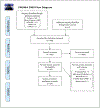Identifying Potential Classification Criteria for Calcium Pyrophosphate Deposition Disease: Item Generation and Item Reduction
- PMID: 33973414
- PMCID: PMC8578594
- DOI: 10.1002/acr.24619
Identifying Potential Classification Criteria for Calcium Pyrophosphate Deposition Disease: Item Generation and Item Reduction
Abstract
Objective: Classification criteria for calcium pyrophosphate deposition (CPPD) disease will facilitate clinical research on this common crystalline arthritis. Our objective was to report on the first 2 phases of a 4-phase process for developing CPPD classification criteria.
Methods: CPPD classification criteria development is overseen by a 12-member steering committee. Item generation (phase I) included a scoping literature review of 5 literature databases and contributions from a 35-member combined expert committee and 2 patient research partners. Item reduction and refinement (phase II) involved a combined expert committee meeting, discussions among clinical, imaging, and laboratory advisory groups, and an item-rating exercise to assess the influence of individual items toward classification. The steering committee reviewed the modal rating score for each item (range -3 [strongly pushes away from CPPD] to +3 [strongly pushes toward CPPD]) to determine items to retain for future phases of criteria development.
Results: Item generation yielded 420 items (312 from the literature, 108 from experts/patients). The advisory groups eliminated items that they agreed were unlikely to distinguish between CPPD and other forms of arthritis, yielding 127 items for the item-rating exercise. Fifty-six items, most of which had a modal rating of +/- 2 or 3, were retained for future phases. As numerous imaging items were rated +3, the steering committee recommended focusing on imaging of the knee and wrist and 1 additional affected joint for calcification suggestive of CPP crystal deposition.
Conclusion: A data- and expert-driven process is underway to develop CPPD classification criteria. Candidate items comprise clinical, imaging, and laboratory features.
© 2021 American College of Rheumatology.
Figures
References
-
- Zhang W, Doherty M, Bardin T, et al. European league against rheumatism recommendations for calcium pyrophosphate deposition. Part i: Terminology and diagnosis. Ann Rheum Dis 2011;70:563–70. - PubMed
-
- Ramonda R, Musacchio E, Perissinotto E, et al. Prevalence of chondrocalcinosis in italian subjects from northeastern italy. The prova study. Clin Exp Rheumatol 2009;27:981–84. - PubMed
-
- Maravic M, Ea HK. Hospital burden of gout, pseudogout and other crystal arthropathies in france. Joint Bone Spine 2015;82:326–9. - PubMed
-
- Felson DT, Anderson JJ, Naimark A, et al. The prevalence of chondrocalcinosis in the elderly and its association with knee osteoarthritis: The framingham study. J Rheumatol 1989;16:1241–5. - PubMed
Publication types
MeSH terms
Substances
Grants and funding
LinkOut - more resources
Full Text Sources
Other Literature Sources
Research Materials



